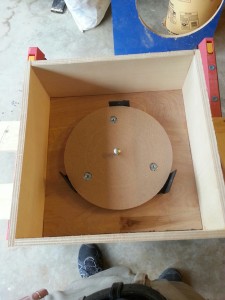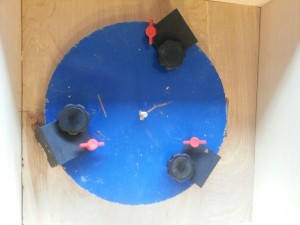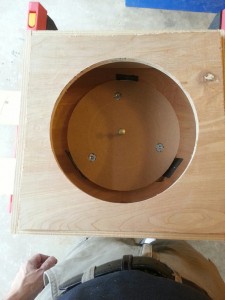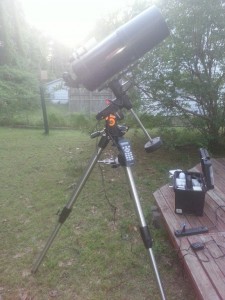In the latest episode of Extreme Makeover: Telescope Edition, Jim makes more rings, a box, and something to put in the box. First, I made two plywood rings that will be the basis of the secondary cage which holds the secondary mirror, the focuser, a finder, and maybe a soda. Next I worked on the mirror box and primary mirror cell which I started on yesterday. You can see the cell sitting in the open box, the back side of the cell with its collimation screws salvaged from the original tube, and finally the cell back in the box with the upper surface of the box.
Next up, not necessarily in this order will be to finish the cell and mae it with the primary mirror, construct the secondary cage, build the truss arms, assemble, determine the balance point so that I will know where the previously covered altitude bearing will be attached then build the rocker box, sand, paint, get the soda from its place in the secondary cage and enjoy.
10″ Dobsonian Makeover Project
About 18 months ago, someone contacted CAAS about a 10″ Coulter Odyssey OTA that her brother had owned and asked about how to sell it. That sparked an interest and I wound up buying it. I made a quick and dirty mount for it, remember it was an OTA only, but once I got it assembled I realized that that for whatever reason the focuser was too close (or maybe it was too far) to come to focus. Disappointed, I set it aside until another day. Since that time I’ve been thinking about performing a makeover on it to turn it into a more compact (for storage at least) and usable scope.
I’ve done research and come up with ideas. Last weekend I did my first router work and cut an 18″ circle out of MDF. This was actually meant to be a test of the process but when I was done it was pretty good so I may well use it. Regardless this or another circle will be cut in half and probably hollowed out a bit to make the altitude bearings. Hollowed out to save weight.
This afternoon I disassembled the old OTA bagging up the parts I want to bring forward to the new scope. These are the focuser, the secondary, the telrad finder, and the primary (of course). The primary was well attached to the original MDF mirror cell with silicone that though pliable was not separating easily. I finally decided I was going to damage the mirror if I didn’t try another way so mirror and MDF cell are soaking in warm soapy water right now. I hope to be able to remove the ruined cell easily when done and have a clean mirror to boot. Making a new cell should be straight forward.
The original secondary and holder are rather plain, a straight rod that runs across the tube with a mirror attached. Of course, Coulter was in bang for the buck business and you can’t expect Obsession at Odyssey prices. It works and I might try to use it at least to begin with but that may have to be replaced.
The focuser is an aftermarket ScopeStuff Crayford model and might be the most valuable part after the mirror itself so its a keeper.
A couple years ago, someone gave me the carousel part of a Dobsonian. Probably a 12″. I’m not obligated the use it but that would be a part I didn’t have to make if I do. The size would make for stability but it might also look a 6 year old walking around in his dad’s shoes. Of course in my case dad and I had the same size feet when I was six.
More later.
Below is the 18″ MDF round that I cut.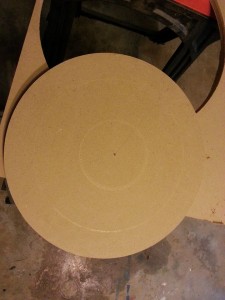
Celestron Advanced VX Mount First Impressions
- The tripod legs are probably not actually larger but they seemed that way.
- What are larger and more substantial are several threaded things like the latitude and azimuth adjustment screws. I think they have gone from 1/4” to 3/8” with larger knobs.
- The counterweight rod is longer and the standard counterweight is 12 pounds instead of the previous 11.
- The electronics of the mount now a second accessory port.
- The ports are well marked and since there is concern that you could plug something into an incorrect port and damage the electronics the three of five ports that not as commonly used have a flip-down cover and the declination drive cord has a label warning you to not plug it into an autoguider or accessory port. The power port is threaded so that if your power cord is too then you are less likely to unplug it accidentally.
- The clamps to lock your scope to the mount head are, like others mentioned earlier, more substantial than before. The ASGT essentially had one clamp plus an emergency backup clamp. With the AVX the two are identical and each larger than the main clamp of the ASGT.
- Speaking of clamps, the RA and Declination clamps only turn about an 1/8th turn from loose to tight. I’ll learn over time if that will increase with use.
- The home position markers are not the simple labels that the ASGT, though that did work, and are much easier to see.
- The back of the polar access does not have the simple pull off cap of the ASGT but a stouter screw off cap.
- A significant improvement is in the enclosure for the declination worm gear. In the ASGT this turned with the tube assembly and there as a point in the sky, close to the zenith, where this would run into the mount causing you at a minimum to shut everything down and restart your alignment. In the AVX this enclosure does not spin and is also pointed forward so that this cannot happen.
- The mount is much quieter when slewing to a new position. With the ASGT everyone knew when you moved from Venus to Jupiter, with the AVX it might just be your neighbors.
- One thing I miss is the built-in bubble level and the only place to set one is on the tripod leg spreader.


